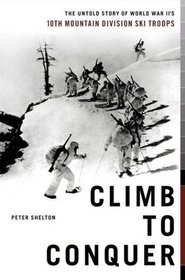Search -
Climb to Conquer : The Untold Story of WWII's 10th Mountain Division Ski Troops
Climb to Conquer The Untold Story of WWII's 10th Mountain Division Ski Troops
Author:
Few stories from the "greatest generation" are as unforgettable -- or as little known -- as that of the 10th Mountain Division. Today a versatile light infantry unit deployed around the world, the 10th began in 1941 as a crew of civilian athletes with a passion for mountains and snow. In this vivid history, adventure writer Peter Shelton follows... more »
Author:
Few stories from the "greatest generation" are as unforgettable -- or as little known -- as that of the 10th Mountain Division. Today a versatile light infantry unit deployed around the world, the 10th began in 1941 as a crew of civilian athletes with a passion for mountains and snow. In this vivid history, adventure writer Peter Shelton follows... more »
ISBN-13: 9780743226066
ISBN-10: 0743226062
Publication Date: 10/28/2003
Pages: 288
Rating: 1
ISBN-10: 0743226062
Publication Date: 10/28/2003
Pages: 288
Rating: 1
4 stars, based on 1 rating
Genres:
- History >> Europe >> Italy >> General
- History >> Military >> World War II >> General
- Sports & Outdoors >> Winter Sports >> Skiing >> General




